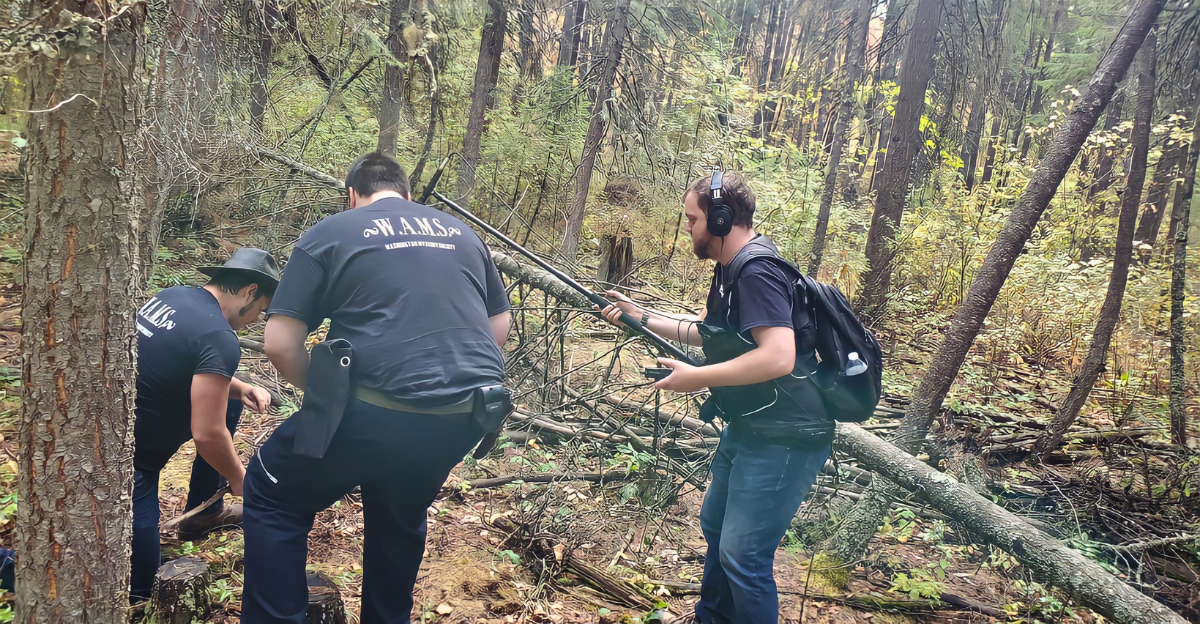
Hikers exploring Joseph D. Grant County Park in Santa Clara County stumbled on something they never expected, a large black-and-white reptile moving through the dry brush. At first, many thought it might be just a large lizard that escaped from someone’s backyard. But experts quickly identified it as an Argentine black-and-white tegu, a species not native to California but rather to South America.
What made this sighting alarming was not just its size but also its reputation as an invasive predator. The hikers alerted park rangers immediately, and within hours, officials began investigating to confirm the reptile’s presence. Word quickly spread through the community and raised both curiosity and concern. So, this single tegu sighting set off an urgent response by ecologists, park rangers, and county officials, all determined to act before this visitor became a bigger problem.
Urgent Search Begins

After receiving the hikers’ report, park rangers wasted no time. Knowing the risks this reptile could pose, they organized immediate search teams and kept the public informed through local alerts. The urgency came from the fact that tegus are not harmless garden visitors. These reptiles feed on bird eggs, insects, small mammals, and even native reptiles, which makes them a serious threat to the local food chain.
Biologists point out that they are tough to remove once tegus settle into new areas. According to People Magazine, “Even a single invasive lizard can start a ripple effect that reshapes an ecosystem.”
California’s Ongoing Battle

California has long been on the front lines of invasive species battles, from plants that choke rivers to animals that disturb fragile food webs. The case of the Argentine tegu at Joseph D. Grant County Park simply added a new chapter to this ongoing challenge. Though sightings of unusual reptiles have been reported before in the Bay Area, few species carry the same risk level as tegus.
These lizards are exceptionally hardy, tolerant of different climates, and clever when it comes to finding shelter. This combination makes them a special concern for wildlife officials. A report by Fox Weather noted, “The real issue is not one animal—it’s whether it can establish a breeding population.”
Community on Alert

As news of the tegu’s presence spread across Santa Clara County, officials turned to the public for help. Community awareness, they stressed, was the strongest tool against potential spread. Residents were urged to report any similar sightings to authorities immediately, but warned not to attempt to capture themselves. Rangers explained that when invasive animals are chased, they can become even harder to find later.
A county spokesperson from UPI reminded residents, “Your phone photo can save wildlife, but your direct intervention could make things worse.” Without these citizen alerts, many outbreaks would have gone unnoticed until they were too large to control. In California’s case, officials considered the public a partner in the tegu search, not just bystanders.
Tegu Captured and Community Relieved

After five days filled with uncertainty and countless patrols in Joseph D. Grant County Park, park rangers finally managed to track down and safely capture the elusive Argentine tegu on the dam at Grant Lake. The operation, which involved coordinated teamwork between rangers, maintenance staff, and animal services, was praised for its speed and effectiveness. The tegu was not harmed and was transferred to a county animal shelter, where staff began the process of searching for its owner or preparing for its possible adoption.
“It’s always a relief to be able to resolve something humanely; our team did a fantastic job,” a park official told reporters. The capture quickly spread through social media, calming the nerves of many locals who were anxious about the threat to park wildlife.
Locals Stay Watchful

With the tegu safely contained, people living near Joseph D. Grant County Park breathed a collective sigh of relief. Still, conversations and worries about exotic pets and invasive species remained. Many park regulars remembered past incidents where snakes, iguanas, or other reptiles had turned up unexpectedly after escaping from homes in the Bay Area. Local environmental groups used this moment to warn the public. Just one tegu in the wild could potentially attract mates and lead to a population boom, a scenario that’s happened before in other states.
“It’s never just one problem—these things ripple,” said a longtime park volunteer, describing how challenges with invasive animals can quickly multiply and complicate habitat management. Residents and visitors kept their eyes open during hikes, hoping they wouldn’t encounter another exotic creature lurking in the brush.
Native Wildlife Under Threat

Tegus are known to eat bird eggs, small mammals, native lizards, and even insects, which disrupts the food chain and breeding cycles of more vulnerable species. In places like Florida, where tegus have become established, their hunting habits have pushed some native species closer to extinction.
Biologists in California worry about similar scenarios, especially if tegus manage to hide or reproduce before they’re found. The sighting in Joseph D. Grant County Park made it clear that wildlife managers must stay ready to respond quickly.
Preventing Pet Escapes

Conservation specialists argue that improper releases and pet escapes are a major source of new invasions. Laws and rules have started changing, with more calls for strict pet trade regulations, mandatory microchipping, and better breeding controls for potentially risky animals.
Advocacy groups are encouraging owners to act responsibly, and state officials have suggested that the first line of defense against invasions is smarter pet ownership. The incident at Grant County Park encouraged even more legislative discussions about how to stop pets from becoming problems.
Science Steps Up

The U.S.U.S. Geological Survey and other science groups are building better tools for spotting invasive reptiles early and responding fast. Their strategies include mapping risk zones, using advanced monitoring systems, and getting residents involved in “citizen science” projects designed to track unusual animals in local parks.
Biologists are hopeful that Early Detection Rapid Response (EDRR) systems will give California’s wildlife teams the advantage they need to spot and contain invaders before they get a foothold.
Many Unusual Reptiles Seen

The tegu wasn’t alone in making headlines. Over the last few years, California’s parks have recorded other unwanted guests, like iguanas and even escaped pet pythons. Officials note that wild sightings of non-native reptiles and amphibians pop up from Los Angeles to the Bay Area. These animals, often escapees from homes or pet stores, keep park managers and scientists busy.
During California Invasive Species Action Week, residents are encouraged to report these sightings and take photos to help build better maps and response plans. Conservationists urge people not to wait for someone else to step in: “Even one photo can tip the scales for recovery efforts.”
Getting the Public Involved

Local and state agencies haven’t kept quiet about the dangers of letting pets loose or not reporting strange animals. In fact, there are now special campaigns designed to boost awareness, most notably, California’s “Don’t Let It Loose!” program. The campaign uses social media, workshops, and newsletters to educate pet owners about the problems caused by releasing unwanted animals into parks or lakes.
The goal is to reduce cases where exotic animals end up in unintended places, causing costly environmental and financial troubles. Volunteers and animal lovers get training on how to spot, report, and help remove invasive species. “Every Californian can be part of the solution—just look, learn, and let us know what you see,” say campaign organizers.
Rethinking Pet Rules

With the captured tegu sitting in a shelter, local leaders began to ask tough questions about exotic pet laws and responsibilities. Ideas ranged from stricter registration requirements and better containment for dangerous animals to buy-back programs encouraging owners to surrender illegal reptiles rather than dump them outdoors.
Discussions focused on the need for continuous evolution of laws for everyone’s benefit. One county supervisor said, “When laws evolve, we can better protect both people and nature.” These proposals aim to reduce incentives for pet owners to take shortcuts.
Putting Habitats First

After the tegu was removed, conservationists quickly shifted focus to healing the land and preventing future damage. Recovery starts with hands-on habitat restoration—removing invasive species, fixing up natural areas, and teaching the public about the region’s original wildlife.
California Invasive Species Action Week offers workdays where volunteers can get involved directly in removing problem plants and animals and learning what needs protecting. Success depends on the continued dedication of these community members, who remain alert for signs of new threats.
Teamwork Across States

Joseph D. Grant County Park’s tegu incident inspired new cooperation among agencies, universities, and nonprofits across California and beyond. These groups share data, collaborate on research, and coordinate joint responses to prevent the spread and settlement of invasive animals.
The ongoing challenge has convinced experts that sharing intelligence and standardizing rules across state lines is vital. As a scientist involved in recent collaborations said, “Protecting nature isn’t a solo effort—it’s a network of expertise and action.”
Looking Ahead for Threats

Experts warn that the tegu finding should not be seen as a one-off event. Instead, scientists urge park managers and officials to use “horizon scanning”, a method of researching and anticipating what invasive species might arrive next. University of California, Riverside, research shows that nearly half of new invasives in the state first come from somewhere else in the U.S..
Dr. Mark Hoddle notes, “Anticipation saves habitat,” emphasizing the need for tighter import controls, more thorough checks on pet and plant shipments, and stronger ties with federal authorities.
New Laws on the Horizon

After officials successfully captured the tegu, lawmakers began work on stronger rules to prevent future risks. Hearings were scheduled to discuss pet trade regulations focused on microchipping, licensing, and improving how agencies share information. Scientists support these changes, saying better laws will help track exotic species faster and prevent escapes.
Funds have also been proposed for new technologies that detect invasive reptiles, like DNA sampling and AI-driven image recognition. If these reforms pass, they could set the standard for wildlife protection not just in California, but across western states.
Industries Respond to Change

Pet shops, breeders, and animal shelters followed the news closely, aware that new rules might change how animals are bought, imported, or adopted. Changes to laws can also affect agriculture and aquaculture, two fields sensitive to invasive pests.
When regulations tighten, businesses have to adjust quickly. New standards can mean extra costs for microchipping, containment, permits, and paperwork. As a result, many companies are preparing for state-wide changes.
Social Media Sparks Discussion

The tegu’s capture was widely seen, shared, and debated online. Videos quickly went viral, and some rumors even exaggerated the danger posed by the lizard. County staff responded fast, reminding people that while tegus are usually docile, they are very disruptive to the environment and should be reported, not approached.
Past Mistakes

Florida’s python boom and Georgia’s tegu colonies showed that weak regulation and slow public outreach lead to long-term environmental costs. “Documenting successful early detection and rapid response (EDRR) is critical to designing stronger future systems,” according to a recent case study.
California officials now use Joseph D. Grant County Park as a national example, showing how early reports and coordinated responses can save local habitats before a problem spirals out of control.
What We’ve Learned

The incident proved that even one unusual animal can shake up an entire ecosystem. “Vigilance and shared responsibility are the odds-on path forward,” wildlife advocates say. Protecting California’s wild spaces is an ongoing team effort, with all residents playing a part in shaping a safer future for local plants and wildlife.